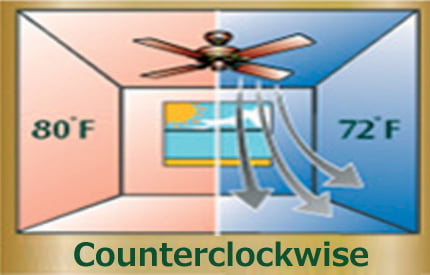Ceiling fan is ceiling mounted electric fan that use electricity as a source of energy to drive the blades to rotate and accelerate the flow of air, mainly for air circulation to cool off and relieve the heat.
The motor of a ceiling fan has a low speed but a high torque. However, air conditioners with ceiling fans can effectively reduce the indoor temperature quickly by circulating positive rotation (cold air falling), as opposed to heaters with ceiling fans that circulate negative rotation (hot air rising), which can effectively raise the indoor temperature and reduce air conditioning electricity costs by 15% to 40%.
Does the ceiling fan turn clockwise or counterclockwise?
Ceiling fans are a common cooling appliance in summer and when it’s hot you can turn them on by flicking a switch or pressing a button on the remote control to use them. But come winter, then you forget about them. But did you know that there is a simple trick to make your ceiling fan available all year round?
Almost every ceiling fan is designed to rotate clockwise and counterclockwise. Most people are familiar with the benefits of the counterclockwise movement of a fan: it creates a downward airflow to cool you down – perfect for when it’s hot in the summer. The downward airflow from a ceiling fan can even make you feel as cool as 8 degrees Fahrenheit, which means you can rely less on your air conditioner in the summer.
What many people may not know is that you can also make your ceiling fan a must-have for the colder months by simply changing the direction of the fan to clockwise rotation. Turn the fan on to get warmer, as the clockwise direction draws cold air upwards and forces warm air downwards, which is very useful any time during the winter or colder months. With snow and ice storms hitting much of eastern North America, you can turn to your trusty ceiling fan to help cope with the stormy and cold temperatures.
Which way should your fan spin in summer or winter?
There should be a switch on the ceiling fan motor housing below the blades. This quick and easy adjustment allows your fan to be used in any season.I f your ceiling fan has a remote control, it may have a button to reverse the direction of the fan blades.
Winter: clockwise
In winter, you don’t want cold air blowing on you. Because of this, most people instinctively turn off their ceiling fans. Turning clockwise is another option for you. When you want a warm effect, your ceiling fan should be turned clockwise. Instead of pushing the cold air downwards, it pulls it upwards, which forces the warm air (remember, heat rises) near the ceiling back down.
Summer: counterclockwise
During the hottest months of the year, you want your fan to cool you down. To do this, you need your ceiling fan to push the air downwards and your ceiling fan should be turned counter-clockwise. This downward airflow creates a cool wind chill effect, perfect for summer.
Important things to remember
This technique is not only for use in summer or winter – you don’t have to have it turning counterclockwise all summer and clockwise all winter. If you want a room to feel warmer or cooler, simply reverse the direction of the ceiling fan to make you feel more comfortable, without having to rely too much on your AC power

